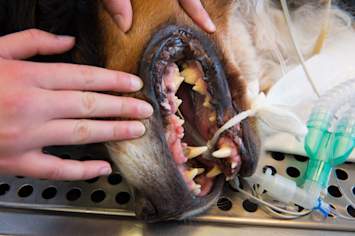
You’ve probably wondered “why is my pet’s dental cleaning so expensive?” But, are they truly expensive when you see what all is involved? There are many ways dental cleaning and teeth extractions for our pets are different than our own trip to the dentists. These thorough cleanings can address a multitude of dental issues, including persistent dog bad breath that home care alone might not resolve. Let’s talk a little more about what happens during a dental cleaning and then see if it still seems pricey...
The first question I often get is, “why does my dog need to be put under anesthesia to get his teeth cleaned?” Well, one reason is that I have become fond of my fingers over the years! The real reason is that a dog or, god forbid a cat, is not going to allow you to do a thorough cleaning without being knocked out.
But, it’s so much more than just the anesthesia. After your pet is dropped off, their dental appointment begins when a veterinarian does an exam on your pet. We will listen to his heart to make sure there are no murmurs and examine the pet to be sure anesthesia is safe. The tech then draws blood to do a mini chemistry to check the liver and kidneys, the two organs that metabolize the anesthesia. Then they administer a pre-sedative to calm the pet, but also so we can decrease the amount of anesthesia that will be needed. Next, an IV catheter is placed, so that we can later administer an induction agent, usually propofol and midazolam, a water-soluble Valium. For older animals we also put them on IV fluids while under, helping to maintain good blood flow.
Next, the tech inserts an endotracheal tube and your pet is attached to an anesthesia machine. We hook your pet to a pulse oximeter to monitor pulse rate and blood oxygen concentration throughout the procedure. Lastly, we cover the pet with a Bear Hugger warm air circulating blanket to maintain body heat, a major factor in allowing the animal to metabolize the anesthesia correctly and wake up from the anesthesia quickly. After all that we can start the actual dental cleaning!
The tech starts by chipping the large pieces of tartar off with dental ronguers. This is a very satisfying step! Once that is done we use a machine called a Calverton, which is a vibrating instrument that uses ultrasonic vibrations to clean the small material off the teeth. Then comes the most important step. The tech uses special instruments to clean under the gums, removing tartar and plaque that is not visible. This is a time consuming step, but this removes the most dangerous material that causes infection to the tooth roots. Once that is done the gum line is carefully probed around each tooth, to make sure there are no pockets of gum recession. If pockets are found, it’s time to take dental radiographs to detect if there are any root abscesses. Dental x-rays are extremely important because an infected tooth will look completely normal under the gum line, but can have significant root abscesses only evident on x-rays. The vet will examine the teeth and review the radiographs to see if a tooth needs to be removed.
Removing teeth in dogs and cats is actually much more difficult than removing human teeth due to the root structure. Human tooth roots tend to go straight up, whereas those of dogs and cats will be in more of a divergent pattern, making more of a V shape often necessitating the vet to use a dental burr to cut the tooth in sections and remove it in multiple pieces. Often, the gum needs to be lifted and gingival flaps made to get to the tooth roots. After the tooth is removed, sutures are needed to put the gums back in the proper position. Human teeth are normally removed in one piece and often do not require sectioning or suturing. A dental cleaning, without extractions, is normally completed in 60 to 80 minutes. But, adding in extractions can tack on another 60 minutes per tooth.
After all this is done, all four sides of the teeth are polished with a polishing machine and paste. Finally, the teeth receive a fluoride treatment. The pet is then given an injection for pain relief and antibiotics if needed and we dispense pain meds and antibiotics to go home.
Now that you see that it takes an entire team a good chunk of the day to perform a dental, does it seem so expensive? Dental health is so important to our animals’ overall health, which is why it's so important to invest in pet dental insurance.